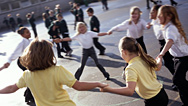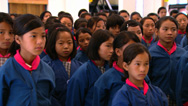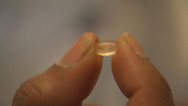Stabilizing Vaccines with Silk
- By Ari Daniel
- Posted 08.28.14
- NOVA
At the moment, vaccines must be kept cold up until the moment that they are administered to a patient. This poses a problem in the developing world where infrastructure can interrupt the refrigeration during storage and transport. Numerous labs and companies are working to solve the problem. For instance, one Cambridge-based startup called Vaxess is using an extract from silk to stabilize vaccines, and their preliminary results are promising.
Transcript
Stabilizing Vaccines with Silk
Posted: September 5, 2014
Ari: We take it for granted in the U.S. But millions of adults and children around the world don’t have access to basic vaccines for diseases like polio, diphtheria, and measles.
Schrader: The problem certainly is most prevalent throughout high temperature regions of the world. Hot and humid do great damage to vaccines. They degrade when exposed to room temperatures or elevated temperatures for long periods of time—the same way milk or any other perishable item would. So therefore, we have to keep them cold or frozen in some cases in order to keep them active and effective.
Kosuda: They need to be shipped on refrigerated trucks or refrigerated planes. Packing these products in ice and loading them on the back of a donkey, or a camel even. So that by the time the vaccine arrives halfway across the world and is delivered to a child in a rural area, the vaccine is still good.
Ari: But breaks in the cold chain are common, which can result in vaccines being thrown away.
Schrader: So what if you could take these vaccines, make them more temperature stable so that they could be shipped at room temperature, elevated temperature, high humidity conditions?
Ari: These challenges of vaccine storage and delivery have been taken up by numerous labs and companies around the world. Some are proposing adding tiny polymers to stabilize the vaccines. Others are attempting to dry the vaccines out before they’re shipped. Vaxess Technologies, located in Cambridge, Massachusetts, is exploring a different idea.
Kosuda: These professors at Tufts made this amazing discovery, so using a protein that’s found from silk, you can actually use it to stabilize vaccines. It actually helps to hold the vaccine in place. Some vaccines are made up of weakened or inactivated viral particles.
Schrader: So if you’ve got viral particles floating around and they bump into each other and stick, they lose their potency. You add the silk proteins, and they create a barrier between those products bumping into each other. So they kind of sit in the middle, prevent that aggregation, thereby keeping the vaccine more effective.
Kosuda: Basically, we start with natural silk fibers. And we’re interested in extracting one protein from those silk fibers called fibroin.
Schrader: Fibroin is the core of the fiber. That’s the protein we want to work with. It’s coated with an adhesive protein that we don’t want.
Kosuda: It’s the glue that holds the fibers together. So the first thing we do is we boil the silk fibers to remove that adhesive protein, and you’re left with something that basically looks like this. So these are pure fibroin fibers.
Ari: The next step involves dissolving these fibers, and the result is then added to the vaccine, protecting the viral particles.
Kosuda: This is essentially what a silk-stabilized vaccine would look like. So the idea is that once this vaccine is formulated with the silk protein, it can be stored and shipped around the world without refrigeration. And when it reaches the health care clinic in some rural area, essentially the vaccine is just taken out, and it’s reconstituted and then injected for use.
Schrader: If everything continues to progress as we envision, we see this technology hitting the market within five to six years.
When I was a kid growing up in Indiana, access to vaccines was just a given. Every child had them—they were protected from diseases like polio and measles. And because of that, they could focus on being a kid. And to realize and step back and think that there are children around the world that have paralysis due to polio or blindness potentially due to measles, and they are not able to have that same, healthy, fun childhood is really a big part of what drives us everyday to come in and make sure that this technology does make it to market.
Ari: If it’s up to Vaxess and the other labs and companies pursuing solutions to this problem, access to vaccines might just become a standard for medical care, around the world.
Credits
PRODUCTION CREDITS
- Produced by
- Ari Daniel and Kristen Clark
- Narrated by
- Ari Daniel
- Original Footage
- © WGBH Educational Foundation 2014
MEDIA CREDITS
- International Video
- © Bill & Melinda Gates Foundation
- Map
- Wikimedia Commons/PhilippN (CC by 3.0)
- Viruses
- © Brent Johnson
- Silk Micrograph Courtesy of
- Alpretec
- Music
- Free Music Archive/BOPD (CC by 3.0)
IMAGE
- (main image: Handheld Vial)
- Ari Daniel and Kristen Clark
Related Links
-

Vaccines—Calling the Shots
Examine the science behind vaccinations, the return of preventable diseases, and the risks of opting out.
-

Fighting HPV in Bhutan
Bhutan is the first developing country to embrace a vaccine to fight cervical cancer.
-

Tiny Tattoo Vaccines
New miniature vaccines may be administered like painless tattoos.
-

Brushes with Death
Dorothy Roseman describes her close encounters with vaccine-preventable diseases.

